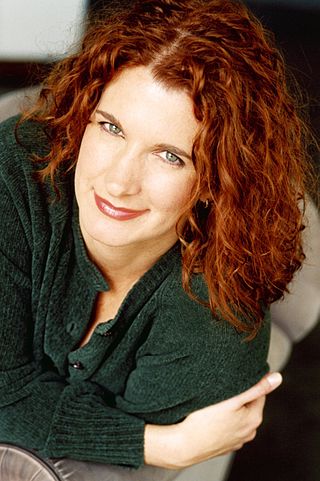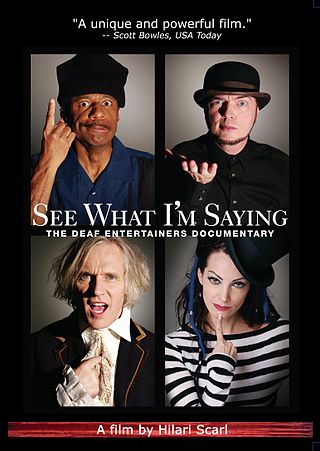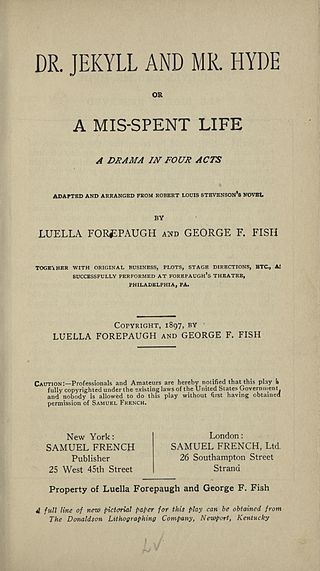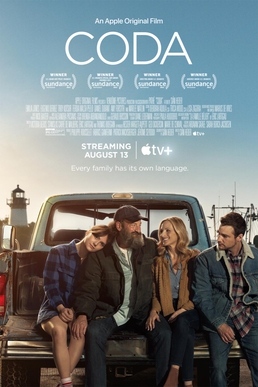
American Sign Language (ASL) is a natural language that serves as the predominant sign language of Deaf communities in the United States of America and most of Anglophone Canada. ASL is a complete and organized visual language that is expressed by employing both manual and nonmanual features. Besides North America, dialects of ASL and ASL-based creoles are used in many countries around the world, including much of West Africa and parts of Southeast Asia. ASL is also widely learned as a second language, serving as a lingua franca. ASL is most closely related to French Sign Language (LSF). It has been proposed that ASL is a creole language of LSF, although ASL shows features atypical of creole languages, such as agglutinative morphology.

Sign languages are languages that use the visual-manual modality to convey meaning, instead of spoken words. Sign languages are expressed through manual articulation in combination with non-manual markers. Sign languages are full-fledged natural languages with their own grammar and lexicon. Sign languages are not universal and are usually not mutually intelligible, although there are also similarities among different sign languages.

French Sign Language is the sign language of the deaf in France and French-speaking parts of Switzerland. According to Ethnologue, it has 100,000 native signers.

Deaf culture is the set of social beliefs, behaviors, art, literary traditions, history, values, and shared institutions of communities that are influenced by deafness and which use sign languages as the main means of communication. When used as a cultural label especially within the culture, the word deaf is often written with a capital D and referred to as "big D Deaf" in speech and sign. When used as a label for the audiological condition, it is written with a lower case d. Carl G. Croneberg coined the term "Deaf Culture" and he was the first to discuss analogies between Deaf and hearing cultures in his appendices C/D of the 1965 Dictionary of American Sign Language.
Signing Exact English is a system of manual communication that strives to be an exact representation of English language vocabulary and grammar. It is one of a number of such systems in use in English-speaking countries. It is related to Seeing Essential English (SEE-I), a manual sign system created in 1945, based on the morphemes of English words. SEE-II models much of its sign vocabulary from American Sign Language (ASL), but modifies the handshapes used in ASL in order to use the handshape of the first letter of the corresponding English word.
Frank Wildhorn is an American composer of both musicals and popular songs. His musical Jekyll & Hyde ran for four years on Broadway. He also wrote the #1 International hit song "Where Do Broken Hearts Go" for Whitney Houston.
Manually Coded English (MCE) is a type of sign system that follows direct spoken English. The different codes of MCE vary in the levels of directness in following spoken English grammar. There may also be a combination with other visual clues, such as body language. MCE is typically used in conjunction with direct spoken English.

Jekyll & Hyde is a 1990 musical loosely based on the 1886 novella The Strange Case of Dr Jekyll and Mr Hyde by Robert Louis Stevenson. Originally conceived for the stage by Frank Wildhorn and Steve Cuden, it features music by Frank Wildhorn, a book by Leslie Bricusse and lyrics by all of them. After a world premiere run in Houston, Texas, the musical embarked on a national tour of the United States prior to its Broadway debut in 1997. Many international productions in various languages have since been staged including two subsequent North American tours, two tours in the United Kingdom, a concert version, a revamped US tour in 2012, a 2013 Broadway revival featuring Constantine Maroulis, and an Australian concert version in 2019 starring Anthony Warlow.
Singapore Sign Language, or SgSL, is the native sign language used by the deaf and hard of hearing in Singapore, developed over six decades since the setting up of the first school for the Deaf in 1954. Since Singapore's independence in 1965, the Singapore deaf community has had to adapt to many linguistic changes. Today, the local deaf community recognises Singapore Sign Language (SgSL) as a reflection of Singapore's diverse linguistic culture. SgSL is influenced by Shanghainese Sign Language (SSL), American Sign Language (ASL), Signing Exact English (SEE-II) and locally developed signs.

CJ Jones is an American actor residing in Los Angeles. He is one of the subjects of See What I'm Saying: The Deaf Entertainers Documentary (2009). Jones made his feature film debut with Edgar Wright's Baby Driver (2017), in which he portrays Joseph, the deaf foster father of Ansel Elgort's protagonist.
American Sign Language literature is one of the most important shared cultural experiences in the American deaf community. Literary genres initially developed in residential Deaf institutes, such as American School for the Deaf in Hartford, Connecticut, which is where American Sign Language developed as a language in the early 19th century. There are many genres of ASL literature, such as narratives of personal experience, poetry, cinematographic stories, folktales, translated works, original fiction and stories with handshape constraints. Authors of ASL literature use their body as the text of their work, which is visually read and comprehended by their audience viewers. In the early development of ASL literary genres, the works were generally not analyzed as written texts are, but the increased dissemination of ASL literature on video has led to greater analysis of these genres.

TL Forsberg is a Canadian hard of hearing singer, songwriter and actress who proudly embraces the word "deaf" She is a graduate of George Brown Theatre School, Forsberg performed as the singer/front person for the band KRIYA which opened for Alanis Morissette and Tori Amos at the Molson Canadian Amphitheatre in 1999. Forsberg, is perhaps most known for her candidacy as the hard of hearing singer as one of four subjects, along with CJ Jones, Bob Hilterman, Robert De Mayo profiled in the 2010 award-winning documentary See What I'm Saying: The Deaf Entertainers Documentary.

Hilari Scarl is an American filmmaker who directed and produced the documentary See What I'm Saying: The Deaf Entertainers Documentary (2009), starring Bob Hiltermann, TL Forsberg, CJ Jones and Robert DeMayo. She also produced No Ordinary Hero: The SuperDeafy Movie (2013).

See What I'm Saying: The Deaf Entertainers Documentary is a 2010 feature documentary produced and directed by Hilari Scarl. It focuses on the lives of deaf entertainers Bob Hiltermann, TL Forsberg, CJ Jones, and Robert DeMayo and their attempts to cross over to mainstream audiences. These talented entertainers overcome great challenges on their way to personal triumphs and professional success.
Chuck Baird was an American Deaf artist who was one of the more notable founders of the De'VIA art movement, an aesthetic of Deaf Culture in which visual art conveys a Deaf world view. His career spanned over 35 years and included painting, sculpting, acting, storytelling, and teaching.
Giphy, styled as GIPHY, is an American online database and search engine that allows users to search for and share animated GIF files.

Strange Case of Dr Jekyll and Mr Hyde is an 1886 Gothic novella by Scottish author Robert Louis Stevenson. It follows Gabriel John Utterson, a London-based legal practitioner who investigates a series of strange occurrences between his old friend Dr Henry Jekyll and a murderous criminal named Edward Hyde.

Dr. Jekyll and Mr. Hyde, Or a Mis-Spent Life is a four-act play written in 1897 by Luella Forepaugh and George F. Fish. It is an adaptation of Strange Case of Dr Jekyll and Mr Hyde, an 1886 novella written by the Scottish author Robert Louis Stevenson. The story focuses on Henry Jekyll, a respected London doctor, and his involvement with Edward Hyde, a loathsome criminal. After Hyde murders a vicar, Jekyll's friends suspect he is helping the killer, but the truth is that Jekyll and Hyde are the same person. Jekyll has developed a potion that allows him to transform himself into Hyde and back again. When he runs out of the potion, he is trapped in his Hyde form and commits suicide.

CODA is a 2021 coming-of-age comedy-drama film written and directed by Sian Heder. An English-language remake of the 2014 French-Belgian film La Famille Bélier, it stars Emilia Jones as Ruby Rossi, the titular child of deaf adults (CODA) and only hearing member of her family, a teenager who attempts to help her family's struggling fishing business while pursuing her own aspirations of being a singer.

Troy Michael Kotsur is an American actor in theater, film, and television. His supporting role in the film CODA (2021) earned him a number of accolades, including an Academy Award, a British Academy Film Award, a Screen Actors Guild Award, and a Critics' Choice Movie Award. He is the first deaf actor to win the latter three awards, and first deaf man and second deaf performer overall to win the first.













